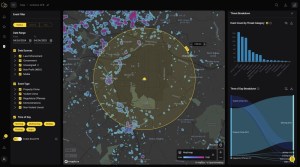Four ways DOD can leverage AI for contested logistics

In today’s age of modern warfare, the DoD is hard-pressed to maintain effective and resilient logistics operations. Contested logistics, characterized by hostile environments, limited resources, and the presence of adversaries, pose real challenges to the U.S. military and its ability to manage current supply chains. Currently, forces are challenged to move supplies quickly and efficiently in the face of imminent attacks from our adversaries. This is where artificial intelligence (AI) holds the most promise within the DoD.
AI and other automated technologies can not only help agencies address these ongoing security challenges, but they can also augment personnel in managing contested logistics effectively. Here are four promising applications of AI to enhance the resilience and efficiency of defense logistics operations within contested environments: forecast demand, route planning, threat detection, and joint information sharing.
Forecasting Demand to Inform Allocation
Predictive analytics can help assist in forecasting the potential demand for critical supplies. Using AI-powered analytics, DoD leaders can analyze historical data—including operational patterns, previous shipments, mission details, and more—to better understand the volume, frequency, and end locations of shipments, and thus predict future needs. Leveraging this info, logisticians can make more informed decisions regarding the defense supply chain, properly allocating critical resources to be shipped to the appropriate theater.
Automate and Adapt Route Planning
AI-powered autonomous systems can help address critical tasks in logistics planning, including route planning, fleet management, and resupply operations. Algorithms can analyze data from sensors, satellites, and drones in real-time to identify disruptive events and dynamically adapt logistics operations to reroute the transportation of resources to sites. Further, autonomous systems, notably unmanned aerial vehicles (UAVs), can be used to help physically transport the required materials, avoiding risk to human personnel and ensuring the delivery of essential resources to deployed forces.
Minimize Disruptions to the Defense Supply Chain
As defense agencies are expected to remain agile and adaptable in the face of modern warfare, it’s critical that defense logisticians see and address concerns before they cause major disruptions. AI can enable advanced risk assessment and mitigation strategies within the military services. In particular, machine learning solutions can analyze large and disparate data sets to monitor the supply chain, identify patterns and potential risks, and help defense agencies proactively address vulnerabilities in logistics operations before they cause any major disruption. By detecting and responding to threats early on, AI can enable leadership to make faster, more informed decisions on what’s next, helping to safeguard operations and ultimately maintain the integrity of defense supply chains.
Joint Force Collaboration
AI and automation can also support collaboration and communication amongst joint forces—both within the U.S. military and with its allied partners. If granted appropriate access through programs like JADC2, AI-enabled systems can automatically report on the inventory of certain assets, challenges in transporting materials across specific domains, and recent patterns of disruption to the defense supply chain, including internal, environmental, and adversarial threats. Further, tools like natural language processing can extract insights from this shared intelligence to enable joint leadership to make faster, better-coordinated decisions.
The opportunities for AI to support military logistics, especially in contested environments, are considerable—and while some services are more advanced in their adoption of AI-enabled tools for logistics operations, others may be wary due to the continuous concerns around cybersecurity and ethics. Continued conversations on governance and accountability are essential pieces of this puzzle and must be held at the leadership level, but in order to ease further concerns, it’s also important for military services to look at organizations already implementing AI for logistics in the commercial sector.
Some of the world’s largest organizations utilize AI to optimize their logistics efforts and build resiliency, and they’ve tested and refined strategies to safeguard their supply chains through the technology. By replicating these efforts for the defense sector and taking full advantage of AI’s ability to predict, automate and manage processes, military services can begin to revolutionize their logistics operations.
As the DoD continues to explore using AI in its operations, we should expect to see continued improvements in logistics efficiency and effectiveness, making it more effective for U.S. forces to operate in contested environments and best defend the nation.
Art Sellers is Director of Army Programs at SparkCognition Government Systems. He previously served for more than 27 years as a U.S. Army infantry officer.






